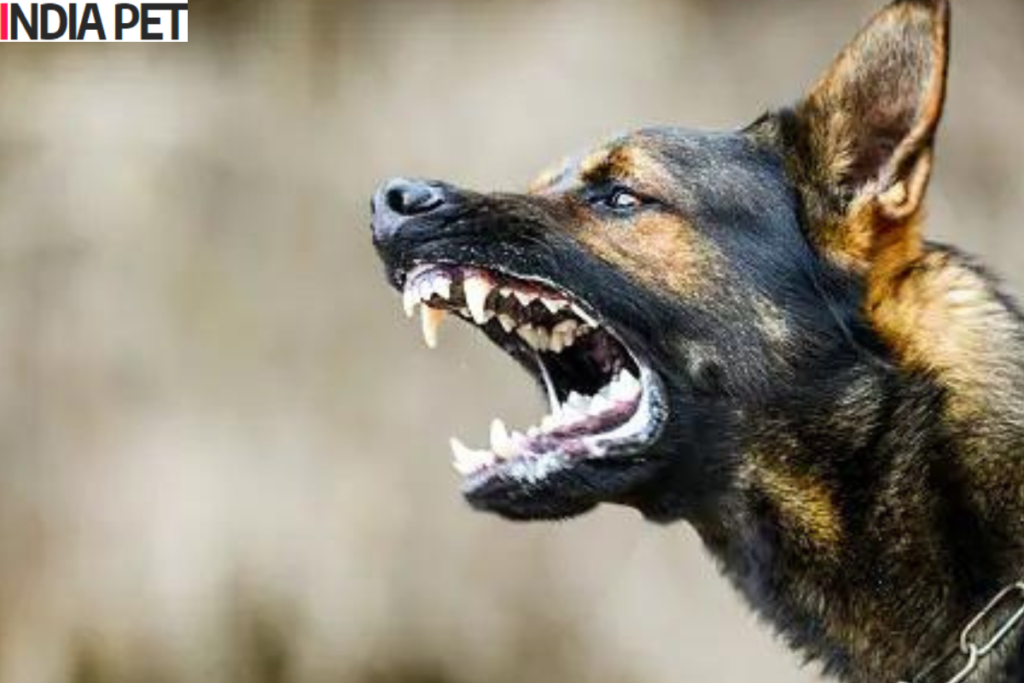How to Stop Jealousy and Aggression in Dogs – Jealousy and aggression in dogs can be challenging for pet owners to manage, but you can help your dog overcome these negative behaviors with the right strategies. This blog will guide you through How to Stop Jealousy and Aggression in Dogs by identifying signs of these behaviors and offering practical techniques to address them.
How to Stop Jealousy and Aggression in Dogs
- Signs of Jealousy and Aggression in Dogs:

Growling or Snapping: Dogs may growl or snap at other pets, people, or objects they perceive as threats.
Possessiveness: Guarding toys, food, or even people can indicate jealousy.
Pushy Behavior: Pushing between you and another pet or person is a sign of jealousy.
Destructive Actions: Chewing, digging, or other dangerous behaviors may stem from jealousy or aggression.
Excessive Barking: Barking at the source of their jealousy or aggression is common.
Attention-Seeking: Clinging to you or demanding more attention when another pet or person is around can be a sign.
Sudden Withdrawal: If your dog suddenly withdraws from social interactions, it might be due to underlying jealousy.
Increased Anxiety: Signs of stress, such as pacing or whining, can also indicate jealousy and aggression.
Also read : Why Do Dogs Have Wet Noses? – Know the 5 Reasons
- Techniques and Strategies to Address Jealousy and Aggression:

- Establish Leadership Through Training
Consistent Commands: Use clear and consistent commands to establish yourself as the leader.
Obedience Training: Regular obedience training can help assert your position and provide structure.
Set Boundaries: Clearly define boundaries for your dog, such as not allowing them on furniture unless invited.
Daily Routine: Maintain a consistent daily routine to provide structure and reduce anxiety.
- Introduce a Reward System
Positive Reinforcement: Reward good behavior with treats, praise, or affection.
Ignore Negative Behavior: Do not reward or react to jealous or aggressive actions, as this can reinforce them.
Use Distractions: Redirect your dog’s attention with toys or activities when they show jealousy.
Clicker Training: Consider using clicker training to reinforce positive behaviors quickly.
- Incorporate the Source of Jealousy in Training

Controlled Exposure: Gradually introduce the source of jealousy in a controlled environment.
Pairing with Rewards: Reward your dog when they remain calm around the source of jealousy.
Increase Interactions Slowly: Increase the time and closeness of interactions to desensitize your dog.
Monitor Body Language: Pay close attention to your dog’s body language to gauge comfort levels.
Also read : Why do dogs growl when they play {2024}
- Improve Relationship Between Pets
Shared Activities: Engage in activities that both pets enjoy to create positive associations.
Equal Attention: Ensure both pets receive equal attention to reduce jealousy.
Separate Feeding Areas: Provide separate spaces for eating to prevent food-related aggression.
Supervised Playtime: Ensure playtime is supervised to prevent conflicts and reinforce positive interactions.
- Control Aggression

Identify Triggers: Determine what triggers your dog’s aggression and work to minimize these situations.
Use a Muzzle: In severe cases, a muzzle can prevent biting while you work on behavior modification.
Seek Professional Help: Consider consulting a professional dog trainer or behaviorist if aggression persists.
Gradual Desensitization: Slowly expose your dog to triggers in a controlled manner to reduce reactivity.
Also read : Top 11 Extremely Most Dangerous Dog In The World
- Foster a Relationship with a Child
Supervised Interactions: Always supervise interactions between your dog and children to prevent misunderstandings.
Teach Respect: Educate children on how to interact with dogs gently and respectfully.
Reward Calm Behavior: Reward your dog when they remain calm and friendly around children.
Role-Playing: Practice scenarios with your child to help your dog get used to their presence.
- Self-Care for You and Your Dog
Stay Calm: Your dog can sense your emotions; staying calm can also help them remain calm.
Exercise Regularly: Regular physical activity can reduce stress and aggression in your dog.
Take Breaks: If you feel overwhelmed, take a break to recharge; your well-being is important too.
Mental Stimulation: Provide mental challenges like puzzle toys to keep your dog’s mind occupied and reduce stress.
Conclusion
Understanding How to Stop Jealousy and Aggression in Dogs requires patience, consistency, and love. By recognizing the signs of jealousy and aggression and implementing these strategies, you can create a more harmonious environment for your dog and other family members. Training, positive reinforcement, and a balanced relationship are critical components in helping your dog overcome these challenges. Remember, every dog is unique, and it may take time for your dog to adjust, but with persistence, you can make a significant difference in their behavior.
FAQs
-
What are the common triggers for jealousy in dogs?
Common triggers include the presence of new pets, babies, or significant changes in the household that shift attention away from the dog.
-
How long does it take to stop dog jealousy and aggression?
The time varies depending on the dog's personality, training consistency, and the severity of the behavior. It can take weeks to months.
-
Can jealousy and aggression in dogs be eliminated?
While it may not be eliminated, these behaviors can be significantly reduced with proper training and care.
By understanding How to Stop Jealousy and Aggression in Dogs, you are taking a vital step toward ensuring your dog’s well-being and maintaining peace in your home. With time, patience, and the right approach, you can help your dog overcome these challenging behaviors.


